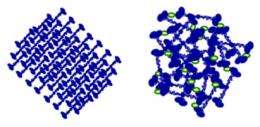Therapy for fearsome brain disease could target blood

(PhysOrg.com) -- The aggregated proteins strewn about a deranged brain are the hallmark of one of the most feared and common neurodegenerative disorders on the planet: Alzheimer’s disease. But while these irregular, gunky proteins, called amyloid-β, are believed to contribute to the deterioration of memory and cognitive ability in Alzheimer’s patients, no one knows how they lead to these symptoms, and the severity of the dementia doesn’t directly depend on the amount of amyloid-β plaques found in diseased brains.
New experiments from The Rockefeller University, building on a paper published earlier this year, show how amyloid-β interacts with a clotting agent in the blood, increasing blood clots that are harder than usual to break down and starving neurons of their regular supply of oxygen. The research suggests that the effects of amyloid-β on the blood vessels feeding the brain could be an important aspect of the havoc they wreak on the brain.
“There has been a suggestion that vascular dementia and Alzheimer’s disease might be related, and our current work provides a possible connection between the two,” says Sidney Strickland, head of the Laboratory of Neurobiology and Genetics at Rockefeller.
Led by Hyung Jin Ahn, a postdoctoral associate in Strickland’s lab, researchers used biochemical tests to home in on exactly how a particularly nasty form of amyloid-β, called Aβ42, interacts with the blood clotting agent fibrinogen, causing fibrinogen to grow into unusual clot structures that are hard to degrade. Ahn and colleagues show, by incubating Aβ42 and fibrinogen and studying the effects, exactly what pieces of the molecules interact and what happens when they do. The results indicate that the interaction between Aβ42 and fibrinogen may induce abnormal fibrinogen structures prior to fibrin clot formation and that this oligomeric fibrinogen plays an important role in Alzheimer’s disease pathogenesis, Ahn says.
The findings could suggest a drug target for disrupting this interaction, thereby preventing the downstream consequences, which could include decreased blood flow, cognitive dysfunction and inflammation of the neurons.
In June, researchers from the same lab published a report in Neuron demonstrating that amyloid-β leads to the formation of tougher blood clots, and that decreasing the level of fibrinogen could reduce the pathology of Alzheimer’s disease (see video). The latest work, published November 22 in Proceedings of the National Academy of Sciences, shows how those tougher blood clots are formed.
Ahn and colleagues are now in the process of indentifying small molecules that can inhibit the Aβ42–fibrinogen interaction and hope these inhibitors could become an effective drug therapy for patients with Alzheimer’s disease.
More information: Proceedings of the National Academy of Sciences online: November 22, 2010. Alzheimer's disease peptide beta-amyloid interacts with fibrinogen and induces its oligomerization. Hyung Jin Ahna, et al.
















